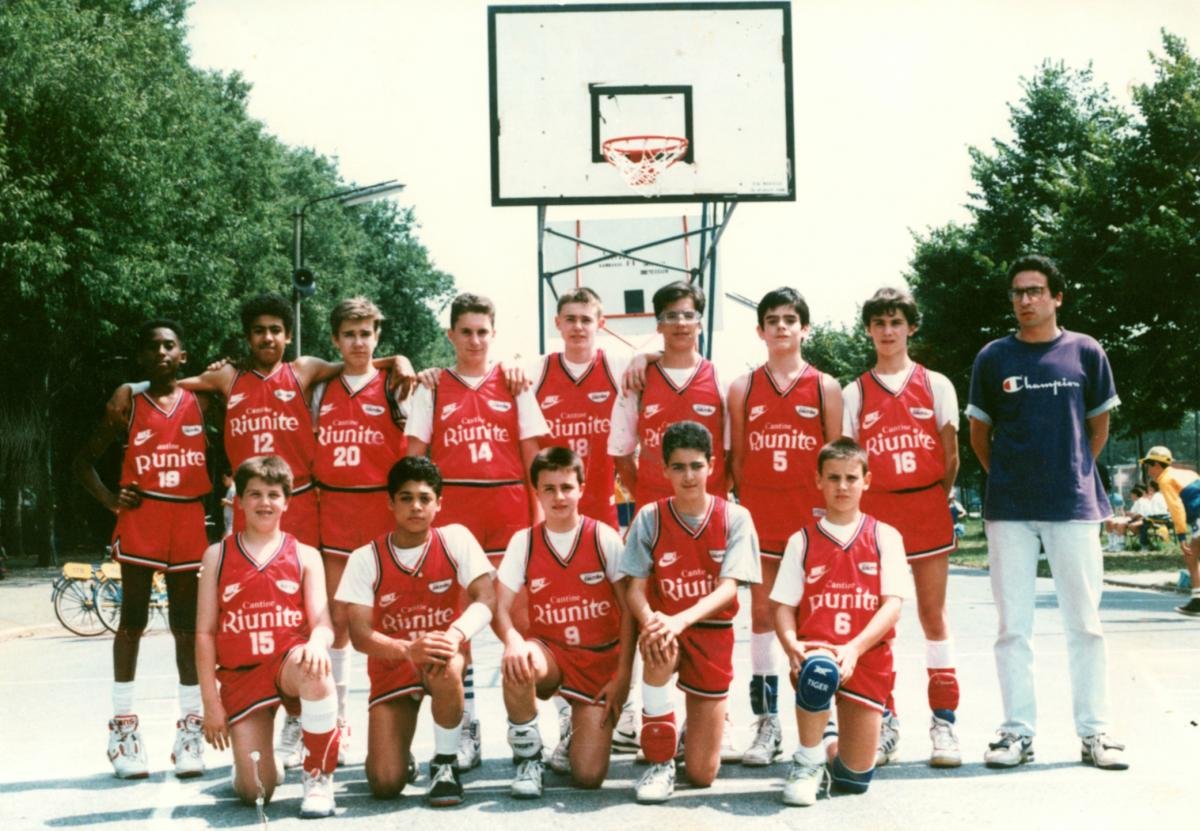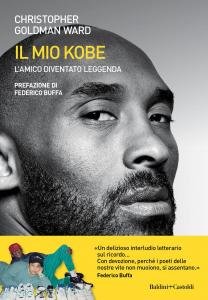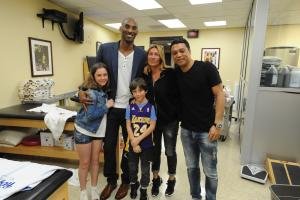Il mio Kobe, la mia Reggio Emilia
Intervista a Christopher Goldman Ward, statunitense di passaporto ma italianissimo nell’anima, che ha pubblicato Il mio Kobe, un memoir sugli splendidi anni reggiani del Black Mamba
8 Febbraio 2022
di Simone Sacco

Il titolo completo è Il mio Kobe – L’amico diventato leggenda e l’ha pubblicato da meno da un mese la Baldini + Castoldi. Autore: Christopher Goldman Ward. Classe 1977, sguardo languido, fisico tonico («Perché, anche alla mia età, continuo a giocare nell’inferno delle leghe minori del basket», scrive lui), doppio passaporto tra Italia e Stati Uniti (la mamma è originaria di Reggio Emilia, il papà dell’Arkansas ed ha combattuto in Vietnam), architetto di professione e amico d’infanzia per l’eternità di un certo Kobe Bryant.
Il suo è un racconto di quasi 160 pagine schietto, caloroso, inevitabilmente nostalgico. Appiccicoso come il sudore che ti si forma sulla schiena dopo un paio di minuti spesi al campetto, profondamente innamorato del Gioco e, almeno per una volta, slegato dalle logiche di un certo storytelling nostrano campato per aria. Quello che un bel giorno ti fa scrivere dei segreti di spogliatoio di Larry Bird, Kevin McHale e Robert Parish e magari, in vita tua, non ti sei mai mosso da Cesano Boscone.
Ward d’altronde c’era eccome da adolescente quando l’ex talento dei 76ers e dei Clippers Joe Bryant sbarcò a Reggio Emilia, sul finire dell’estate 1989, per incendiare il PalaBigi ed elargire il suo talento alla franchigia delle Cantine Riunite (portata quell’anno fino ai play-off scudetto). E con l’ala grande originaria di Philly c’era pure una bella famigliola composta dalla moglie Pamela, dalle sorelle Sharia e Shaya e da un ragazzino, allora appena undicenne ma forse già istrione nel profondo, dal nome strano di Kobe.
Il resto, come si suol dire, è Storia con l’iniziale maiuscola. Oppure con la minuscola come le tante, piccole avventure provinciali di due monelli della pallacanestro raccontate su carta. E la morte del campione (e della figlioletta Gigi) avvenuta su quel fatidico elicottero che sorvolava nel gennaio di due anni fa una stranamente brumosa California? Ovviamente c’è anche quella, ma non ammanta di lugubre scia il resto della lettura.

Christopher, è stato impegnativo portare a termine Il mio Kobe visto che tu nella vita fai l’architetto e non lo scrittore?
No, perché provengo pur sempre da studi classici e, nella miglior tradizione del basket, anche stavolta abbiamo fatto gioco di squadra: io ho buttato giù in maniera compulsiva le bozze e poi c’è stato un bel lavoro di team a livello di correzioni. Pure troppo visto che, rileggendo il libro, mi sembrava oltremodo corretto ed edulcorato a livello di linguaggio. Allora l’ho ripreso in mano e l’ho “sporcato” un po’.
Tragedia di Bryant a parte, l’input qual è stato?
L’ennesima domanda postami sui social su com’era Kobe in vita. Come eravamo diventati amici noi due. In quali occasioni ci fossimo incontrati dopo il suo addio a Reggio nel lontano 1991. Quesiti così, spontanei, da fan. A quel punto mi sono detto: «Basta rispondere in maniera disordinata a questo o a quello: mi devo inventare qualcosa». Il mondo era sospeso per via dello scoppio della pandemia, il mio amico era morto da poco, io avevo parecchio tempo libero a disposizione e così mi sono messo a scrivere di getto. Senza stare troppo a pensare a cosa stesse venendo fuori. Poi mi sono fermato di colpo. Era subentrato un po’ di timore legato al fatto che forse mi stessi facendo coinvolgere da un progetto troppo cinico…
Chi ti ha sbloccato?
Federico Buffa (che firma, a sua volta, la breve prefazione. Ndr). L’Avvocato ha svolto due azioni preziose. Prima mi ha supportato dicendomi che questo memoir era solo un modo per dare qualcosa d’inedito ai tanti tifosi italiani di Kobe. Quindi avrei fatto bene a scordarmi il cinismo e andare avanti coi miei racconti. Poi, dopo aver letto in anteprima le bozze, Federico mi ha anche dato una mano a trovare l’editore giusto. Diciamo che la sua benedizione è stata fondamentale.
I libri altrui, davvero tanti, scritti su Kobe li hai letti?
Non sono un lettore voracissimo, ma di quelli non me n’è sfuggito uno.
Pure l’enciclopedico Showboat, la vita di Kobe Bryant di Roland Lazenby uscito nel 2016?
Pure quello, sì. Ecco, l’intento de ‘Il mio Kobe’ era di essere l’esatto opposto di quello di Lazenby che comunque stimo per la sua impeccabilità giornalistica. Non volevo un libro tecnico, di basket narrato tramite fonti e statistiche, ma la storia di due amici. Se devo dirtela tutta, io non avrei neanche messo il nome di Kobe in copertina! Ammetto però che a quel punto, per la casa editrice, sarebbe stato difficile presentarlo al pubblico.
Una sensazione paradossale che dà il tuo libro – se escludiamo il primo capitolo dove racconti immediatamente di quel maledetto 26 gennaio 2020 – è che Kobe non sembra neanche morto…
Ti ringrazio di averlo notato perché la mia intenzione era proprio quella. Questa è un’opera sulla vita giovanile di Kobe che però, in qualche maniera, deve inevitabilmente citare anche la sua dolorosa scomparsa. E così mi sono levato subito il peso scaricando tutta la commozione all’inizio del libro (il capitolo si intitola ‘Il primo ad andarsene’. Ndr) e poi concentrandomi su cosa avevo combinato di bello, in quegli anni fantastici, col mio amico di lunga data. Non ti parlo solo di Reggio, ma anche quando l’ho reincontrato anni dopo. Con lui che era appena entrato in NBA, viveva già da atleta milionario e veniva a Milano per firmare autografi e partecipare ad eventi promozionali.
Di un’atleta si dice sempre che muoia due volte: il giorno del suo ritiro e in quell’altro, decisamente più fatale, della sua dipartita terrena. Ultimamente è successo anche per Maradona…
Sì, una sorta di scissione tra la fine della carriera sportiva e quella della vita terrena, ci può stare… Nel mio caso c’è stato un ulteriore strappo tra la morte di una persona famosa in tutto il mondo – e in diversi periodi della mia esistenza ho visto Kobe esattamente così: come una superstar irraggiungibile, pure da me – e la scomparsa di un caro amico d’infanzia. E, quando mi si accendeva la lampadina su quest’ultima circostanza, ecco che mi crollava il mondo addosso. In realtà, a periodi, mi succede ancora oggi.
Un altro aspetto del libro è che parla molto anche di te e delle tue varie aspirazioni, non solo della leggenda dei Lakers con indosso la canotta numero 24. Una cosa molto NBA, se vogliamo. Intendo quella di crearsi un personaggio pubblico senza timore di essere visti dall’esterno come presuntuosi…
Già, ma in fondo il vero basket americano è questa roba qui, no? C’è la mentalità degli sport europei, vale a dire il rigore di Cinecittà, e poi c’è l’NBA che ti trasporta subito in una dimensione hollywoodiana con tutti i suoi sfarzi e le sue star piene di soldi.
Un mondo finto che Bryant sopportava, ma non supportava.
Già. La grandezza psicologica di Kobe è che lui ha saputo calarsi in quell’universo di spettacolo e superficialità, venendo però da un’educazione solida e severa. Aver studiato dalle suore di Reggio Emilia e aver usufruito della miglior cultura umanistica che un Paese come l’Italia sa tuttora elargire, be’, è stata sicuramente una marcia in più per il Black Mamba.
Cultura più fisico hanno fatto di Kobe Bryant l’ultimo dei romantici in NBA? Un giocatore umano verso cui ti potevi ancora affezionare?
Assolutamente sì, perché Kobe univa la sua forza fisica a dei fondamentali purissimi. Posso farti dei paragoni? Se Michael Jordan era un campione 1.0 e gli attuali LeBron e Antetokounmpo degli atleti extraterrestri 2.0, io Kobe lo metto esattamente a metà strada: lui era un 1.5 come in quest’epoca di robot potrebbe esserlo giusto lo Steph Curry dei suoi primi anni a Golden State…
Quel mezzo punto in più d’evoluzione come nasce?
Il mio amico ha avuto una grande fortuna: è arrivato a Reggio Emilia nel momento giusto della crescita. Dagli 11 ai 13 anni Kobe si è immerso in un basket italiano ed europeo che negli States si sarebbe solo sognato. Tutti quei tiri liberi che lui perfezionava al campetto fino all’ossessione, magari imponendosi di tenere unite le ginocchia come gli aveva insegnato il padre Joe, sono dettagli tecnici che nella NBA di oggi appaiono come preistoria. E invece la bellezza del Gioco nasce anche da quello. Da ciò che metti da parte nel tuo cervello quando sei ragazzino.
E queste cose Kobe le ha imparate solo a Reggio Emilia? In fondo Joe Bryant lo ha fatto vivere anche a Rieti, Reggio Calabria e Pistoia…
Forse lì era ancora troppo bambino per concentrarsi su alcuni aspetti dell’allenamento. Quel 1989 fu l’anno perfetto per vederlo sbocciare. Una epifania in piena regola. Ovviamente se Joe Bryant fosse rimasto in Italia dopo il 1991 e se si fosse trasferito altrove – che ne so, a Bologna – allora sarebbe stata Bologna la città giusta per osservare Kobe esplodere definitivamente. E a quel punto, penso sia normale, si parlerebbe meno degli anni magici di Reggio Emilia.
Nel capitolo L’ultima volta parli di quello che dovrebbe essere stato il tuo ultimo incontro in vita con Kobe. Aprile 2016: allo Staples Center, durante il suo lunghissimo ‘Farewell Tour’, al termine di una gara tra Lakers e Nuggets con, tra l’altro, Danilo Gallinari in campo. Ma le cose non stanno esattamente così, vero?
No, quello è un refuso visto che io mi riferivo all’ultima volta sul parquet. In realtà c’è stata un’ultimissima occasione, nell’estate successiva, a Reggio Emilia! Sempre l’amata Reggio che ritorna nella vita di Kobe…
Kobe che torna dove tutto era cominciato?
Fu una sorpresa. Lui si era ritirato da poco e, in quel luglio 2016, c’era appena stato il sanguinoso attentato terroristico di Nizza con l’intera Francia avvolta nel lutto. Di conseguenza saltò una tappa promozionale a Parigi e Kobe, di testa sua, volle trascorrere qualche giorno nella sua cara Reggio Emilia, in mezzo ai suoi amici d’allora. Fu un’improvvisata molto bella e spontanea, tipica di uno come lui. Da allora non l’ho più rivisto.
Genitori compresi?
Loro li ho risentiti qualche tempo fa, avvertendoli preventivamente che avrei pubblicato un libro su loro figlio. Mi hanno detto di andare avanti, che si fidavano di me e che sarebbero venuti fuori dei gran bei ricordi. Ora gliene devo spedire un po’ di copie in America.
In italiano?
Sharia e Shaya lo leggeranno senza problemi in italiano. Pamela idem. Su Joe nutro qualche dubbio visto che non si esercita con la nostra lingua da tanti anni. Mi sa che almeno lui se lo dovrà far tradurre…

The full title is My Kobe – The friend who became a legend and it was published less than a month ago by Baldini + Castoldi. Author: Christopher Goldman Ward. Born in 1977, languid look, toned physique (“Because, even at my age, I continue to play in the hell of the minor basketball leagues”, he writes), double passport between Italy and the United States (his mother is originally from Reggio Emilia, his father from Arkansas and fought in Vietnam), architect by profession and childhood friend for all eternity of a certain Kobe Bryant.
His is a nearly 160-page tale that is frank, warm, and inevitably nostalgic. As sticky as the sweat that forms on your back after a couple of minutes spent on the court, deeply in love with the game and, at least for once, untied from the logic of a certain storytelling Italian camp in the air. The one that one day makes you write about the locker room secrets of Larry Bird, Kevin McHale and Robert Parish and maybe, in your life, you have never moved from Cesano Boscone.
Ward, on the other hand, was there as a teenager when the former talent of the 76ers and Clippers Joe Bryant landed in Reggio Emilia at the end of the summer of 1989, to set the PalaBigi on fire and lavish his talent on the Cantine Riunite franchise (which made it to the playoffs that year). The Philly-born forward was accompanied by his wife Pamela, his sisters Sharia and Shaya and a young boy, then only eleven years old but perhaps already a histrionic character, with the strange name of Kobe.
The rest, as they say, is History with a capital letter. Or with a lower case, like the many small provincial adventures of two basketball brats told on paper. And the death of the champion (and of his daughter Gigi) on that fateful helicopter that flew over a strangely misty California in January two years ago? Obviously there’s that too, but it doesn’t cloak the rest of the read with a grim trail.
Christopher, was it challenging to complete My Kobe since you are an architect and not a writer?
No, because I still come from classical studies and, in the best basketball tradition, this time we were a team effort: I compulsively wrote the drafts and then there was a lot of teamwork in terms of corrections. Even too much, since, when I reread the book, it seemed to me to be extremely correct and polished in terms of language. So I picked it up again and “dirtied” it up a bit.
Bryant’s tragedy aside, what was the input?
Yet another question posed to me on social media about what Kobe was like in life. How the two of us had become friends. On what occasions we had met after his farewell to Reggio in 1991. Questions like that, spontaneous, as fans. At that point I said to myself: “Enough of answering in a haphazard way to this or that: I have to invent something”. The world was suspended because of the outbreak of the pandemic, my friend had just died, I had a lot of free time on my hands and so I started writing right away. Without thinking too much about what was coming next. Then I suddenly stopped. There was a bit of fear that I might be getting involved in a project that was too cynical…
Who unlocked you?
Federico Buffa (who, in turn, signed the short preface). The Lawyer carried out two precious actions. First, he supported me by telling me that this memoir was just a way to give something new to Kobe’s many Italian fans. So I would have done well to forget the cynicism and get on with my stories. Then, after reading a preview of the drafts, Federico gave me a hand in finding the right publisher. Let’s just say that his blessing was fundamental.
Have you read the many books written about Kobe?
I’m not a voracious reader, but I haven’t missed a single one.
Even Roland Lazenby’s encyclopedic Showboat, the Life of Kobe Bryant that came out in 2016?
That one, too, yes. Here, the intent of ‘My Kobe’ was to be the exact opposite of Lazenby’s, whom I nonetheless respect for his journalistic impeccability. I didn’t want a technical book about basketball told through sources and statistics, but the story of two friends. To tell you the truth, I wouldn’t have even put Kobe’s name on the cover! I admit, however, that at that point it would have been difficult for the publisher to present it to the public.
A paradoxical sensation that your book gives – if we exclude the first chapter where you immediately tell about that cursed January 26, 2020 – is that Kobe doesn’t even seem dead…
I thank you for noticing that because that was my intention. This is a work about Kobe’s early life, but somehow it must inevitably mention his painful passing as well. And so I immediately got rid of the burden by unloading all the emotion at the beginning of the book (the chapter is titled ‘The first to leave’. Ed) and then focusing on what I had done in those fantastic years with my longtime friend. I’m not just talking about Reggio, but also when I met him again years later. With him who had just entered the NBA, was already living as a millionaire athlete and came to Milan to sign autographs and participate in promotional events.
It is always said that an athlete dies twice: on the day of his retirement and on the other, much more fatal, day of his earthly departure. Lately it has also happened for Maradona…
Yes, a sort of split between the end of the sporting career and the end of the earthly life, it can happen… In my case there was a further tear between the death of a person famous all over the world – and in different periods of my existence I saw Kobe exactly like that: as an unreachable superstar, even for me – and the disappearance of a dear childhood friend. And when the light bulb went on about this last circumstance, the world collapsed on top of me. In fact, in periods, it still happens to me today.
Another aspect of the book is that it also talks a lot about you and your various aspirations, not just the Lakers legend wearing the number 24 jersey. A very NBA thing, if you will. I mean that of creating a public persona without fear of being seen from the outside as presumptuous…
Yeah, but then again, real American basketball is this stuff right here, isn’t it? There is the mentality of European sports, that is, the rigor of Cinecittà, and then there is the NBA that immediately transports you to a Hollywood dimension with all its glitz and its stars full of money.
A fake world that Bryant endured, but didn’t support.
Yep. The psychological greatness of Kobe is that he was able to fit into that universe of spectacle and superficiality, but coming from a solid and strict upbringing. Having studied with the nuns of Reggio Emilia and having benefited from the best humanistic culture that a country like Italy still knows how to bestow, well, it was definitely an extra gear for the Black Mamba.
Did culture plus physique make Kobe Bryant the last of the romantics in the NBA? A human player you could still get attached towards?
Absolutely, because Kobe combined his physical strength with pure fundamentals. Can I make some comparisons? If Michael Jordan was a 1.0 champion and the current LeBron and Antetokounmpo are 2.0 extraterrestrial athletes, I put Kobe exactly halfway: he was a 1.5 as in this era of robots could be just Steph Curry in his early years in Golden State…
How did that extra half point of evolution come about?
My friend had a great fortune: he arrived in Reggio Emilia at the right time of growth. From the age of 11 to 13 Kobe immersed himself in an Italian and European basketball that he would have only dreamed of in the States. All those free throws that he perfected on the court to the point of obsession, maybe even forcing himself to keep his knees together as his father Joe had taught him, are technical details that in today’s NBA seem like prehistory. But the beauty of the game comes from that too. From what you put aside in your brain when you are a kid.
And did Kobe learn these things only in Reggio Emilia? After all, Joe Bryant made him live in Rieti, Reggio Calabria and Pistoia too…
Maybe there he was still too much of a child to focus on some aspects of training. That 1989 was the perfect year to see him blossom. An epiphany in full swing. Obviously, if Joe Bryant had stayed in Italy after 1991 and if he had moved elsewhere – I don’t know, to Bologna – then Bologna would have been the right city to watch Kobe finally explode. And at that point, I think it’s normal, people would talk less about the magical years in Reggio Emilia.
In the chapter The Last Time you talk about what should have been your last living encounter with Kobe. April 2016: at the Staples Center, during his very long ‘Farewell Tour’, at the end of a game between Lakers and Nuggets with, among others, Danilo Gallinari on the court. But things aren’t exactly like that, are they?
No, that’s a typo since I was referring to the last time on the court. Actually, there was one last time, the following summer, in Reggio Emilia! Always the beloved Reggio returning in Kobe’s life…
Kobe going back to where it all began?
It was a surprise. He had recently retired and, in that July 2016, there had just been the bloody terrorist attack in Nice with the whole of France shrouded in mourning. As a consequence, he skipped a promotional stage in Paris and Kobe, of his own mind, wanted to spend a few days in his dear Reggio Emilia, among his friends of that time. It was a very nice and spontaneous improvisation, typical of someone like him. I haven’t seen him since.
Parents included?
I spoke to them again some time ago, warning them in advance that I would be publishing a book about their son. They told me to go ahead, that they trusted me and that some great memories would come out. Now I have to send them a few copies in America.
In Italian?
Sharia and Shaya will read it in Italian with no problem. Pamela will too. I have my doubts about Joe since he hasn’t practiced in Italian for many years. I guess he, at least, will have to have it translated….





Commenti Recenti